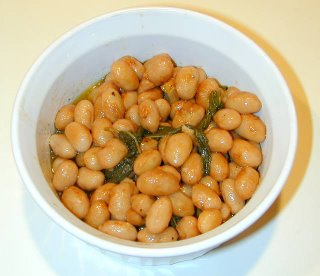
Assunta’s Beans
When we read a story singing the praises of beans, few of us believe it. We mostly encounter beans alongside hot dogs in an overly sweet baked form or as a mushy, side ingredient used to extend soups and chilies. These beans usually come out of cans and contribute little more than starch and after dinner flatulence. We see beans are peasant food, and surely few would pick them as a menu centerpiece if presented with any other choices. Yet beans can be glorious. Beans are a central ingredient in many cuisines around the world and prepared properly, they become a deeply satisfying comfort food.
There are many varieties of beans on the market, mostly found in dried or canned form. Canned beans are convenient, but at the cost of flavor and texture. To keep them from turning to mush, add them towards the end of cooking. Dried beans have more flavor and texture, but require long soaking and cooking to make them edible. They are worth the effort, but take advance planning. But occasionally, you can find fresh beans. They provide an entirely different experience. Try them and you’ll seek them out with pleasure whenever they are in season.
Assunta’s Beans, a dish from Marcella Hazan’s Marcella Cucina (published in 1997) uses fresh cranberry beans. Try the recipe and forever change your mind about beans. Cranberry beans, sometimes called shell beans arrive in speckled red and white pods. Choose pods that feel full with beans and have not begun to brown and dry out.
Ingredients
- 1 1/2 lb unshelled cranberry beans
- 1/3 cup extra virgin olive oil
- 2/3 cup water
- 4 to 6 fresh sage leaves
- 3 garlic cloves, peeled and left whole
- Salt, and black pepper
- A very good extra virgin olive oil to drizzle over the beans when serving

Method
Shell and rinse the beans. Place in a small lidded pot with the olive oil, water, sage leaves, garlic and seasonings. Take a clean kitchen towel (Use one you won’t mind staining. I have one I save specifically for this dish.) Wet it well under a faucet, squeeze out the excess water and fold it to fit the pot lid. Cover the top of the pot with the towel and set the lid over it to seal. Set the pot over a very low flame and cook slowly for an hour and forty five minutes. After 45 minutes check the liquid and ad a few tablespoons of water as needed. Repeat twice more in 20 minute intervals. You may have to adjust the quantity of water to match the level of heat (you don’t want the beans to burn nor bathe in deep water). At the end of the cooking interval, taste the beans, checking for tenderness and to adjust the seasonings.
Serve the beans by themselves, drizzled with some very good olive oil. I like to have them with rice on the side as a complete meal. They are a great accompaniment to roast lamb, pork, chicken and duck.

0 Comments:
Post a Comment
<< Home